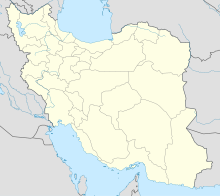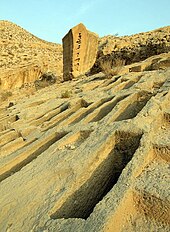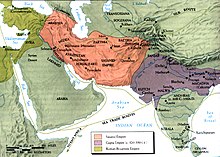Siraf
Coordinates: 27 ° 39 ′ 0 ″ N , 52 ° 20 ′ 0 ″ E
Siraf (also Sirāf , Persian سیراف) was a port and important early Islamic trading center on the coast of the Persian Gulf in what is now the Bushehr Province in Iran . The ruins of the place are located about 220 km south of the city of Bushehr and 380 km west of Bandar Abbas near the modern small town of Bandar Siraf (Bandar-e Sirāf, Bandar-e Taheri, Bandar-i Tahiri, Tāhiri, Tāheri, Tābiri ).
history
The first contact between Siraf and China took place at the time of the Parthians around 185 AD. In the 4th century the city was already a living port and between the 8th century and the end of the 10th century it was probably one of the most flourishing cities in the World. Probably from the Sassanid period, ossuaries are remotely connected to the tomb towers of Palmyra , but not to the tombs of the later Islamic period.
According to David Whitehouse, one of the first archaeologists to uncover the ruins of the port city from 1966 to 1973, maritime trade between the Persian Gulf and the eastern countries flourished due to the surge in trade in consumer and luxury goods. The Persian Gulf served as a sea route between the Arabian Peninsula and India across the Arabian Sea . Small ships, like the Dhau , could cover the long distance by keeping within sight of the mainland on the coast. The eastern end point of shipping was a port named Kalah in Arabic sources , which could have been located on the west coast of the Malaysian state of Kedah and is probably identical to the Geluo of the Chinese sources.
Over time, the port lost its importance and the trade routes moved to the Red Sea . The port was destroyed around 970 AD.
Finds
The port city's archaeological finds include numerous potsherds and glass bowls, ivory objects from East Africa , stones from India and lapis lazuli from Afghanistan .
After Whitehouse, Siraf's oldest mosque dates back to the 9th century. He found ruins of a community mosque surrounded by several others. Other ruins are from the houses of extremely wealthy traders who frequented an international clientele. Particularly influential were those from South India, who were fed extensively during their visits. Records of food plates that were provided for them report this.
literature
- David Whitehouse: Siraf III. The Congregational Mosque and Other Mosques from the Ninth to the Twelfth Centuries. London: The British Institute of Persian Studies, 1980. ISBN 0-901477-02-8
- 'Nicholas M. Lowick: Siraf XV. The Coins and Monumental Inscriptions. London: The British Institute of Persian Studies, 1985. ISBN 0-901477-04-4
- SM Stern: Rāmisht of Sīrāf. A Merchant Millionaire o the Twelfth Century, in Journal of the Royal Asiatic Society 99 (1967), pp. 10-14.
- David Whitehouse: Siraf: A Medieval Port on the Persian Gulf. In: World Archeology, Vol. 2, No. 2 (Urban Archeology) October 1970, pp. 141-158.
- Moira Tampoe: Maritime Trade between China and the West: An Archaeological Study of the Ceramics from Siraf (Persian Gulf), 8th to 15th Centuries AD (= BAR International Series 555). Oxford 1989. ISBN 0-86054-702-7
Web links
Individual evidence
- ↑ Bandar-e Taheri, Iran Page
- ^ The British Museum Siraf project . British Museum
- ^ Robert Hillenbrand: The Development of Saljuq Mausolea in Iran. In: Ders .: Studies in Medieval Islamic Architecture. Vol II. The Pindar Press, London 2006, pp. 319f
- ↑ Iran Seeking Registration of Port Siraf on UNESCO List. ( Memento of the original from April 2, 2015 in the Internet Archive ) Info: The archive link was inserted automatically and has not yet been checked. Please check the original and archive link according to the instructions and then remove this notice. Cultural Heritage News Agency
- ↑ The Seas of Sindbad ( Memento of the original dated February 8, 2007 in the Internet Archive ) Info: The archive link was inserted automatically and has not yet been checked. Please check the original and archive link according to the instructions and then remove this notice.
- ↑ Alastair Lamb: A visit to Siraf, an ancient port on the Persian Gulf. In: Journal of the Malaysian Branch of the Royal Asiatic Society, Vol. 37, No. 1 (205) July 1964, pp. 1-19
- ↑ Sirāf, a Legendary Ancient Port (Cultural Heritage News Agency)
- ^ Luce Boulnois, Silk Road: Monks, Warriors & Merchants . Odyssey Books, Hong Kong: 2005, p. 68 ISBN 962-217-721-2
- ^ Foreign Experts Talk of Sirāf History
- ↑ Article Sirāf on archnet.org ( memento of the original from June 10, 2003 in the Internet Archive ) Info: The archive link was automatically inserted and not yet checked. Please check the original and archive link according to the instructions and then remove this notice.
- ↑ Sirāf, a Legendary Ancient Port (Cultural Heritage News Agency)
- ↑ Nilakanta Sastri. A History of South India . Oxford University Press, New Delhi 1955 (new edition 2002) ISBN 0-19-560686-8


